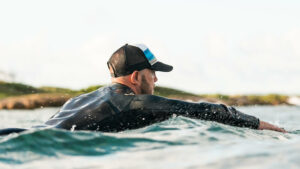Foil surfing is gaining more and more popularity and is taking the center stage among all surfing sports activities. It is a fun and adventurous activity because it allows you to surf above the waves. For this the waves must be slow, crisp and breaking. Without a doubt, foil surfing is becoming more and more common on beaches around the world.
In this article, you will learn:
- That hydrofoil surfboards look different to usual surfing boards
- That foil surfing takes preparation and practice to minimize risks
- That the choice between classical surfing and foil surfing depends on the height of waves
What is hydrofoil surfing?
The regular surfboard has a fin to stabilize the rudder attached to the back of the surfboard to prevent it from sliding sideways. In contrast, in foil surfing, the surfboard is equipped with a hydrofoil instead of fins. It allows the surfboard to glide over the water.
How do hydrofoil boards look like?
A hydrofoil attached under the surfboard and extending into the water is known as a foil board. By harnessing the thermal energy of the underwater wave, the stand-up design allows the surfer to glide with the moving waves. The hydrofoil reduces the effects of harsh weather conditions and strong winds.
Thanks to its underwater properties, the hydrofoil floats on the surface of the water. It allows the surfboard to rise above the water at different speeds. You ride the foil through the water while the board floats above it instead of gliding on the surface of the water.
The hydrofoil is similar to the airfoils used by airplanes. With minimal wave energy, the foil can create lift, allowing the surfer to catch even the smallest of waves without effort. The only difference is that this technology is designed specifically for use in the water to keep the board above the surface.
History of hydrofoil surfing
The ability of the foil board to absorb swell energy and use a jet ski to pull the surfer through a wave was discovered by Laird Hamilton. He was one of the first watermen to attach the foil to a surfboard. The first commercially available electric hydrofoil surfboard was created in 2017 by Lift Foils and went into production in 2018. Many companies have followed Lift in introducing foils to the commercial market.
Is foil surfing dangerous?
As foil surfing becomes more popular, there is growing concern about the risks to riders and other swimmers who may come in contact with a sharp, solid foil.
Some beaches around the world have banned foil surfing in densely populated areas due to an increase in reports of injuries to riders. There are precautionary measures that should be followed when using hydrofoils for activities such as windsurfing, kite surfing, etc.
Compared to hydrofoils, kite surfers and wind foils are larger and riskier. They have longer masts, sharp leading edges and sharp wings. However, both are dangerous and require extra caution when using them. The hydrofoil can be fatal to swimmers, divers, and aquatic creatures.
A fin with wings constructed of aluminum and fiberglass is called a hydrofoil. Although other models have rounded edges and gentle curves, it has a pointed fuselage. In the event of a loss of balance, the foil will not necessarily fly out of the water. The board will often float and sink, acting as an anchor to keep it below the surface.
The best way to learn to foil is to take the support of a boat. A novice foil should refrain from using the boards during crowded lines. Novices who fumble can cause injury and damage. Take in consideration the following points to foil surf safely:
Avoid crowded areas
A foil board does not operate like a regular surfboard once it takes off. With a hydrofoil, you have total three-dimensional control over the board, including roll, pitch, and yaw. Thus, a hydrofoil has the potential to develop into a lethal, hazardous weapon. You must maintain adequate distance and avoid interacting with anyone else.
Stay in the deeper waters
The foil board has a length underneath it while you ride. You may run into rocks, reefs, or beach bars. The hydrofoil will sink and perhaps become snagged in underwater obstructions each time you slow down. So, you should avoid flat water.
Get a proper foil surf training
If it’s your first-time foil boarding, get advice and minimal training from an experienced person. Foil surfing has a relatively high learning curve. You will experience instability and a pendulum-like sensation as you ride the board. Hence, it will take some time for you to develop muscle memory.
Do not ignore beach flags and warning signs
Many beaches across the world have already outlawed foil boarding. Respect all beach flags and cautionary warnings.
Avoid lending your foil board
Avoid lending your foil board to inexperienced friends, as you never know how they will use it. Only lend them your board if they are willing to accept full responsibility for their riding.
Regular maintenance of your foil surfboard
Changes in water temperature or saltwater could lead to malfunctioning of some parts. After each surfing session, clean it before and double-check that all parts are securely fastened.
Apply extra safety
Put on a pair of booties, a wetsuit and a helmet before the surf session. Make sure your board stays with you in case of an incident. Wear a leg rope or roll up your long leash and secure it with Velcro, so it can still extend if necessary. This will ensure your safety and the safety of others.
Always be cautious while you are surfing
Make sure you have a friend or relative nearby in case of an emergency or injury. Start with small lakes, pools, or calm oceans. If you are confident and familiar with how the wing under your feet responds, then only try foiling in the waves.
Traditional surfing vs. Hydrofoil surfing
There are significant differences between traditional and hydrofoil surfing:
| Basis | Traditional Surfing | Foil Surfing |
| Waves | The grip and speed while surfing is influenced by the waves. | Waves are irrelevant. It is far more effective at catching waves. |
| Material | The regular surfer board is made of plastic or fiber fins. It has a fin to stabilize the rudder, fixed to the rear of the surfboard to prevent it from sliding sideways. | In hydrofoil surfing, the surfboard has a metal foil affixed instead of fins. |
| The surface level of the water | The board moves along the water’s surface | The board glides above the surface |
| Cost | It is less costly than a foil surfboard | It is expensive because of the gear and setup cost. |
| Learning curve | It is easy to learn traditional surfing than foil surfing | You might need to take advice and training before starting it. It is tough, hard to learn and more challenging than traditional surfing. You required a lot of practice to master it. You must be cautious at all times while surfing. |
A hydrofoil surfboard is more sturdy than a typical surfboard fin, as it provides more stability. A foil board can practically be used to catch any type of wave, but they’re especially useful for small waves. It is needless to say that you will need a helmet and the hydrofoil setup to attach to your board.
How Hydrofoil works
At first, the water is pushed down toward the wings, but as the surfboard gains speed, the water is pushed up toward the wings. The water reacts to the downward pressure by producing an upward force as it is pushed downward. With this upward force, the person is lifted out of the water and over the waves.
The hydrofoil works according to Newton’s third law, which states that “there is an equal and opposite response to every action in nature”. Compared to conventional surfboards, which take a long time to catch waves, hydrofoil surfboards are more efficient.
Getting training
You must first understand the fundamentals of surfing. Although learning to foil surf can be difficult at first, an experienced surfer can master it in a few hours.
You need to learn how to quickly change the angle of the foil if you can be towed behind a boat or jet ski on your first experience, which will speed up your learning curve. It will also give you an added advantage. You won’t have to worry about steering or paddling in the waves, you can concentrate on gaining stability and learning how to drive the foil while the driver helps you maintain a steady speed.
Stability
The components of the foil platform work together to assess stability. The rider’s weight, technical skill and water type are unavoidable external elements that affect foil stability. Because currents, eddies, and breakers disrupt the depressions and overpressures that induce the upward pull of the foil, a choppy water surface containing these characteristics will be more unstable (like an air disturbance in flight).
The main elements that make a foil more stable are the chord and thickness of the front wing and the surface area and span of the rear wing, also called the stabilizer.
Speed
The surface area and angle of incidence of the front wing affect the speed of the foil. A front wing with less thickness and surface area will be faster. The speed of the foil is influenced by the particular shape of the wing for a given area. A wing with a smaller chord and a larger span will fly faster.
Average speed when foil surfing
The speed required to lift the hydrofoil is 4-8 mph for average weight people. For heavier people, a speed of over 8 mph is required. For thinner people, an even lower speed is required to lift the hydrofoil board.
Lift
The aeronautical concepts that allow aircraft to take off are identical to those that govern the hydrodynamic technology used in hydrofoil surfing. Just as an airplane’s wing directs the airflow under its wings, the hydrofoil’s wing directs the water pressure downward as it moves.
The board and surfer can be lifted out of the water by the pressure created under the foil. Only the foil remains in contact with the water after the board is lifted out. Thus, the smallest surface is in contact with the water. Compared to a conventional surfboard, there is less drag and resistance.
Conclusion: Foil surfing is more demanding than classic surfing.
What we can take away from this article is that foil surfing has become a popular water sport all over the world. Foil surfing allows the surfer to glide through a hydrofoil surfboard with the moving waves. The larger the surface area of the foil, the more stable it is, and the larger the foil area, thickness, chord and angle of attack of a front wing, the stronger the lift, but the slower the speed.
If you want to surf foils, you should ensure maximum safety, avoid crowded areas, wear a helmet, stay in deep water and get training from experienced surfers. Foil surfing is challenging compared to traditional surfing because it has a steep learning curve and requires a lot of practice.









